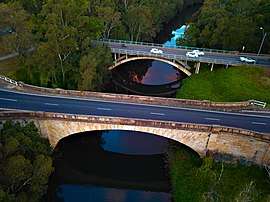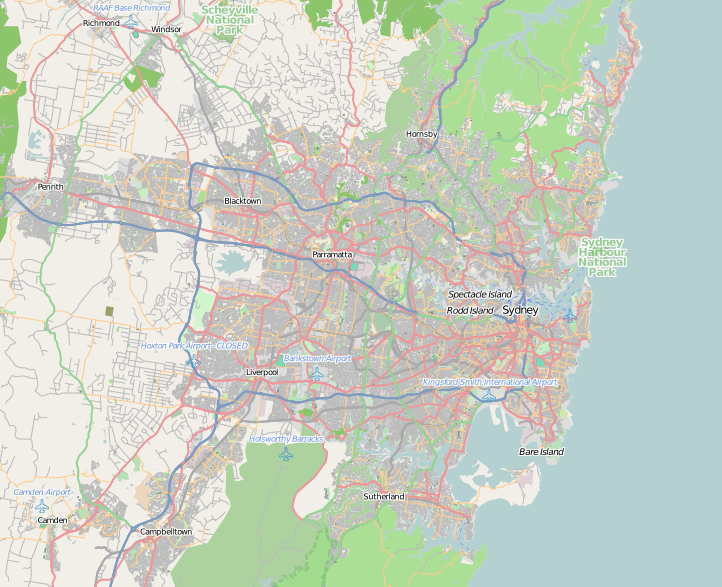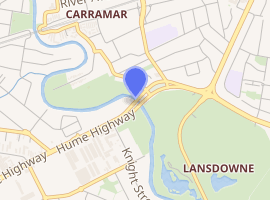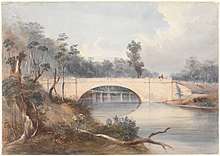Lansdowne Bridge
The Lansdowne Bridge is a heritage-listed road bridge that carries the Hume Highway (A22) across the Prospect Creek at Lansvale in the City of Fairfield local government area of New South Wales, Australia. It was designed and built from 1834 to 1836 by David Lennox. It is also known as Lennox Bridge. The property is owned by Roads and Maritime Services, an agency of the Government of New South Wales. It was added to the New South Wales State Heritage Register on 20 June 2000.[5]
Lansdowne Bridge | |
|---|---|
 Lansdowne Bridge carrying the Hume Highway over Prospect Creek | |
 Location in greater Sydney | |
| Coordinates | 33°53′25″S 150°58′02″E |
| Carries | Hume Highway |
| Crosses | Prospect Creek, New South Wales |
| Other name(s) | Lennox Bridge |
| Named for | Henry Petty-Fitzmaurice, 3rd Marquess of Lansdowne |
| Characteristics | |
| Design | Arch bridge |
| Material | Sydney sandstone |
| Total length | 58 metres (190 ft) |
| Width | 9.1 metres (30 ft) |
| Longest span | 34 metres (110 ft) |
| Clearance above | 9.1 metres (30 ft) |
| History | |
| Designer | David Lennox |
| Construction start | 1 January 1834 |
| Construction end | 1835 |
| Opened | 26 January 1836 |
| Official name | Lansdowne Bridge; Lennox Bridge |
| Type | State heritage (built) |
| Criteria | undefined |
| Designated | 20 June 2000 |
| Reference no. | 01472 |
| Type | Road Bridge |
| Category | Transport - Land |
| Builders | David Lennox |

| |
| References | |
| [1][2][3][4] | |
Opened in 1836, the sandstone arch bridge it has the largest span of any extant masonry bridge in Australia. The bridge is also considered to be one of the finest examples of Colonial architecture in Australia.[6]
History
Lansdowne bridge was designed and supervised by David Lennox. Born in Ayr, Scotland in 1788 David Lennox was trained as a stonemason. He worked on Telford's Menai Suspension Bridge at Anglesey in Wales and on Gloucester Bridge where he learnt the sound construction principles he used on his Colonial projects. He emigrated to Australia in 1832.[5]
He immediately found employment as a mason with the government. While working at the Legislative Council Chambers in Macquarie Street, Sydney, Lennox met the Surveyor-General Sir Thomas Mitchell.[5]
The Surveyor-General lost little time in submitting Lennox's credentials to the Governor, describing him as "a very well qualified person recently arrived in the Colony." Acting on Mitchell's recommendation, Governor Bourke provisionally appointed Lennox as a Sub-Inspector of Bridges at a salary of A£120 per annum. In June 1833 the position was confirmed by London as Superintendent of Bridges.[5]

In 1832, the Surveyor-General at the time, Sir Thomas Mitchell, commissioned Lennox for a sum of A£1,083[7] to build a bridge at the intersection of Prospect Creek and Southern Street,[6][5] which would replace the nearby "Bowler's Bridge" named after Lansdowne's local innkeeper.[8] The sandstone used in designing the bridge was found in a quarry only 11 kilometres (6.8 mi) from the proposed site of the bridge, allowing workers to row a punt to transport the stone to the construction site.[5]
In July 1833 Lennox told Mitchell of a mutiny that had occurred at the quarry while he had been away on an inspection tour. Some of the convicts had rebelled and had consumed the contents of a nearby liquor still. Returning to the camp drunk they threatened to kill the supervisor and destroy the camp and quarrying equipment. The police from Liverpool were called and arrested the offenders. Retribution at Liverpool Court was swift and savage; those who were spared the chain gang received up to fifty lashes of the "cat".[5]
On 1 January 1834, Governor Bourke visited the site of the bridge to lay the foundation stone. Within hours of the laying of the inscription plate it was stolen. Lennox made arrangements to obtain a duplicate plate but the original was found and restored to the bridge.[5] The foundation stone was laid on 1 January 1834. The bridge was constructed entirely by unskilled Australian convicts, despite Lennox's numerous requests to Mitchell for skilled labourers.[8] The bridge was completed a year later in 1835, and opened on 26 January 1836, the 48th anniversary of the Colony of New South Wales, before a crowd of around 1,000.[6][8] Later, Richard Bourke, the Governor of New South Wales, wrote that the bridge had cost only A£1,000 to build, compared to the A£7,000 it would have taken to build a bridge of the same quality in England.[8]
On 7 June 1834 Lennox applied for more labourers, the bridge being at a stage where the centring could commence. This was the construction of a rigid timber frame to hold each stone in place until the arch became self-supporting. It was a critical process and any inaccuracies would cause instability or collapse the arch.[5]
Upon receiving a report that the bridge was nearing completion, Governor Bourke selected 26 January 1836 for the official opening date, as this coincided with the 48th anniversary of the Colony's foundation. The Lansdowne Bridge was not ready for several months as the Toll House was not complete. Once tolls started to be collected however, the bridge soon recovered its cost and in 1844 annual receipts were 685 pounds.[9][5]
In 1956, the New South Wales government duplicated the original bridge with a new concrete arch bridge parallel to the existing to carry southbound traffic of the Hume Highway.[10]
Description
A large sandstone arched bridge spanning the Prospect Creek. The single arch has supporting buttresses. The clear span is 110 feet while the clearance above mean water level is 76 feet at the centre. It has curved abutments and approaches, while the parapets and mouldings are simple and devoid of unnecessary ornamentation. Some of the radiating voussoirs are quite large in size measuring up to eight feet in length.[11][5]
Legacy
In 1973, Australia recognized Lansdowne Bridge for being "one of the finest examples of Colonial Architecture in Australia".[6] In 1990, the Environmental Management Committee Fairfield Council confirmed that Lansdowne Bridge had the largest span of all masonry bridges in Australia and in 1992 that it was an example of excellent construction, which should be preserved.[6][12] Lansdowne Bridge is also listed on the Register of the National Estate[13] and on the National Historic Engineering Landmark list.[8]
Heritage listing
As at 8 November 2000, Lansdowne Bridge is considered to be one of the finest examples of Colonial Architecture in Australia as well as David Lennox's masterpiece of design.[11] Lansdowne Bridge was built by convicts during 1834 to 1836. The sandstone arch has the largest span of any surviving masonry bridge in Australia. The size, appearance and durability make this bridge an outstanding example of colonial engineering.[14][5]
Lansdowne Bridge was listed on the New South Wales State Heritage Register on 20 June 2000 having satisfied the following criteria.[5]
The place is important in demonstrating the course, or pattern, of cultural or natural history in New South Wales.
Lansdowne Bridge is considered to be one of the finest examples of Colonial Architecture in Australia as well as David Lennox's masterpiece of design.[11] Lansdowne Bridge was built by convicts during 1834 to 1836.[5][14]
The place is important in demonstrating aesthetic characteristics and/or a high degree of creative or technical achievement in New South Wales.
The sandstone arch has the largest span of any surviving masonry bridge in Australia. The size, appearance and durability make this bridge an outstanding example of colonial engineering.[5][14]
See also
References
- "The Laytons, Female Emigrants". The Sydney Monitor. VIII (633). New South Wales, Australia. 3 January 1834. p. 2 (MORNING). Retrieved 11 September 2016 – via National Library of Australia.
- "DOMESTIC INTELLIGENCE". The Sydney Herald. III (227). New South Wales, Australia. 30 December 1833. p. 2. Retrieved 30 December 2016 – via National Library of Australia.
- "The Sydney Herald". The Sydney Herald. VI (442). New South Wales, Australia. 21 January 1836. p. 2. Retrieved 10 September 2016 – via National Library of Australia.
- Historic buildings vol III Liverpool and Campbelltown. Cumberland County Council. 1963. pp. 47–51. Retrieved 10 September 2016.
- "Lansdowne Bridge". New South Wales State Heritage Register. Office of Environment and Heritage. H01472. Retrieved 2 June 2018.
- "Lansdowne Bridge over Prospect Creek". New South Wales Department of Roads and Maritime. 7 July 2014. Archived from the original on 23 September 2016. Retrieved 3 November 2015.
- "Votes and Proceedings". The Sydney Gazette and New South Wales Advertiser. XXX (2192). 11 October 1832. p. 3 – via National Library of Australia.
- "Lennox's Lansdowne Bridge" (PDF). The Institution of Engineers Australia. March 1986. Archived (PDF) from the original on 17 November 2015. Retrieved 6 November 2015.
- George, 1982
- The Roadmakers, A History of Main Roads in New South Wales. Department of Main Roads. ISBN 0 7240 0439 4.
- Sheedy, D (1973). National Trust Classification Card - Lansdowne Bridge.
- "Historical Archaeological Sites – Lansdowne Bridge" (PDF). Fairfield City Council. 15 July 1992. Archived from the original (PDF) on 17 November 2015. Retrieved 3 November 2015.
- Australian Heritage Commission (1981). The Heritage of Australia: the illustrated register of the National Estate. South Melbourne The Macmillan Company of Australia in association with the Australian Heritage Commission. p. 2/24. ISBN 978-0-333-33750-9. Archived from the original on 19 September 2016. Retrieved 12 September 2016.
- Environmental Management Committee. Fairfield Council, 1990
Bibliography
- "Lansdowne Bridge". 2007.
- Attraction Homepage (2007). "Lansdowne Bridge".
- Environmental Management Committee - Fairfield Council (1990). Heritage Conservation in Fairfield City - Meeting notes.
- George, Vance (1982). Fairfield: a History of the District.
- Sheedy, D. (1973). National Trust Classification Card - Lansdowne Bridge.
Attribution
![]()
External links
![]()